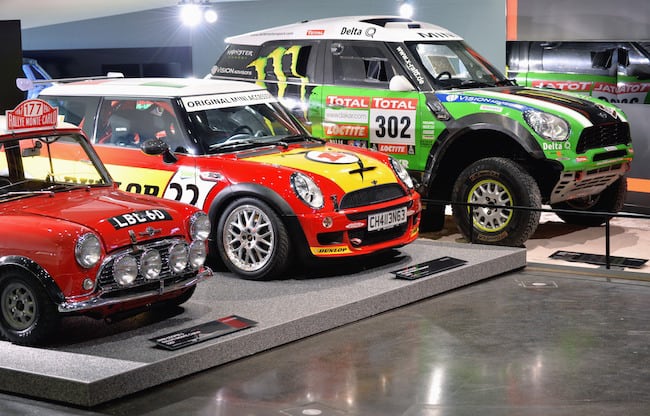
The BMW Welt campus in Munich consists of an enormous showroom displaying the latest BMW cars and motorcycles, as well as BMW’s subsidiary MINI brand cars. Next door, the BMW Museum walks visitors through the dramatic history of the auto manufacturer with hundreds of historic vehicles dating back to the early 1900s.
Part of the museum, the BMW “soup bowl” is a bowl-shaped building for special exhibits with a circular path extending upwards in concentric circles like the Guggenheim New York. Running through January 2016, The MINI Story is the present temporary exhibition discussing the development and evolution of this whimsical and iconic car brand.
For business executives, The MINI Story provides a great example of product marketing and how a brand can be much more than a brand. Founded in 1959, the minuscule car was designed as an economical vehicle with only the barest essentials. It was just supposed to be an eminently practical and cheap mode of transportation, but it turned out to become a cult classic.
At first, the Mini (as the marque was written then) didn’t sell well. Its was too expensive for younger buyers and too spartan for older. Eventually, however, hippies in the 60s gravitated to the car due to its counter-culture design and disrespect for convention. Musicians including members of The Beatles and Mick Jagger bought Minis, and suddenly the Mini was a fashion accessory for creative types as much as a way to get around England.
To further expand the brand’s reach, Mini designed a souped-up rally car driven by racers like James Hunt and Niki Lauda, who eventually became F1 champs, as depicted in the 2014 movie Rush.
By the 1990s, interest in the Mini Classic waned with a advent of so many Japanese small cars in the European market. So BMW decided to completely retool, redesign and reposition the vehicle as the first premium small car. In 2001, the sleek and punchy MINI Cooper hit the showrooms and it was an immediate success. The new iteration (with its name now all capitalized) retained many elements of the Mini Classic version, but the new MINI Cooper was surprisingly much more powerful and it handled like a sports car, inspired by the Mini rally years.
In effect, the MINI Cooper became the first sexy small car for the mainstream auto market.
BMW’s marketing team was intent on exporting Coopers to North America, where the car had never really resonated. In what turned out to be a marketing coup, the famous bank heist scene in The Italian Job movie in 2003 featured three MINIs driven madly through Los Angeles’ underground train sytem.
Since then, BMW introduced convertible Coopers and the larger 5-door MINI Clubman/Countryman crossover series. The MINI Story highlights those near the end of the exhibition alongside a fun array of concept car prototypes, such as an extended beach vehicle with no doors.
If your group is in Munich this year, this is a definite must-see. Also check into renting the BMW Forum of meeting and event spaces.










